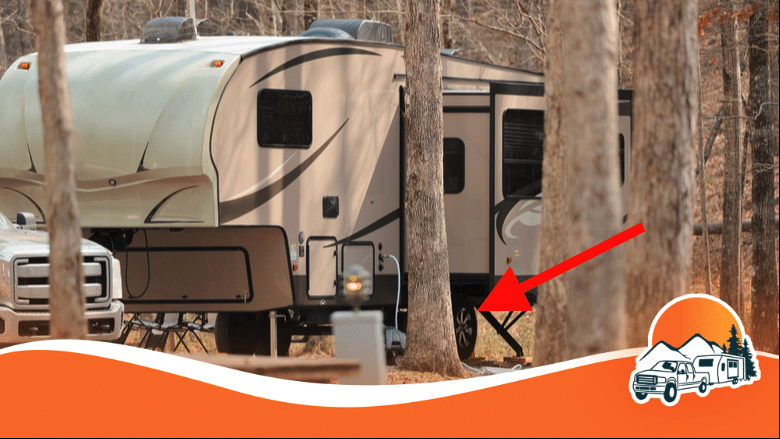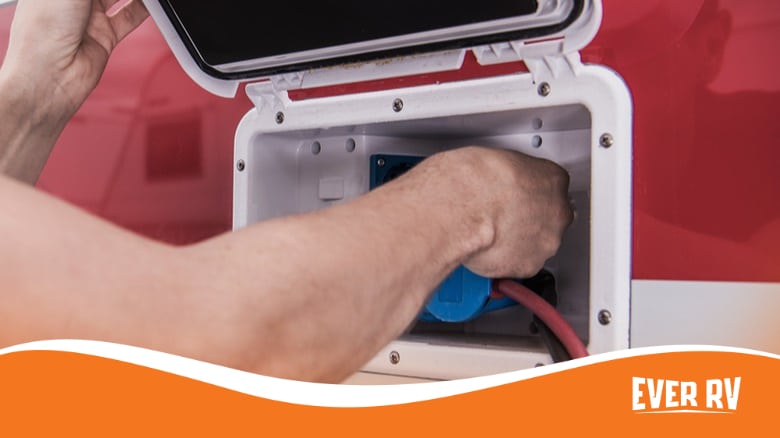One of the significant benefits of traveling in an RV is the home-like comfort you get in it. Besides other amenities, camping trailers hold three tanks: fresh, gray, and black water. When you travel and camp in cold surroundings, keeping the water from freezing can be challenging.

Many campers do not have built-in heaters, which can be a significant problem during winter camping. Understanding everything about heated tanks is essential to avoid any mishap during camping.
Keep reading this article to know everything crucial about heated water tanks for your camper.
What are Tank Heaters?
Tank heaters are specially designed to keep the water in camper tanks warm during low temperatures. These heaters are electric pads attached to the tanker and connected with the camper’s 12V DC electric system through wiring.
You can also get a combination of the AC/DC system, which can be connected to a portable generator when needed. If you do not have a portable generator, you can connect your tanker to the camping site’s power system too.
The size of the heating pad depends upon the camper’s size. Usually, one heating pad per tank is enough, but the number can vary depending upon the camper size. You can find a tank’s capacity by multiplying its height, width, and length and dividing the answer by 231.
Depending upon the surrounding temperatures, you can switch the heaters on and off. You should turn them on whenever temperatures drop below freezing point. The heat from pads can also keep the surrounding pipes warm, keeping them from bursting.
Understanding Tank Designs
The installation process depends upon the design of your camper. When buying a heating pad, make sure you know well whether it will fit your tank. You should also know the optimal spot on the tank to place the heating pad.
Some tanks have stiffening ribs inside them. If your tank has them, place the heating pad deep inside the depression to attach it firmly. Make sure you have double-checked the rank measurement to buy the right heating pad.
Heating Pads Installation
Once you have measured the tank’s dimensions, it is time to install the heating pads. Heating pad manufacturers usually provide instructions for their installations. If they haven’t, you can follow the following valuable tips:
- Remove dust and debris from the spot where you want to place the heating pad by washing it with soap and water
- Dry it with a cleaning rag.
- Clean it again with isopropyl alcohol and finally dry it.
Mostly heading pads are attached to the bottom of the tank because they keep the discharge valves warm. Attach them to the tank using the sticky side and press firmly, but do not stretch them.

Who are Tank Heaters For?
Tank heaters are for those who regularly camp in cold areas where the temperature often drops below freezing levels. It is an inexpensive addition, so anyone can afford it and keep themselves safe during winter camping.
Campers who go out only during the spring and summer seasons do not need this upgrade. Similarly, those who head towards the south during the winter also do not require tank heaters.
Heating Pads Safety
Manufacturers often recommend turning off the heaters when there is no water inside the tank. Heaters should also be turned off when temperatures rise or you are emptying the tank to avoid damage.
When to Turn On a Tank Heater?
Think of the tank heater as an electric blanket that you turn on during winters and turn off when temperatures rise. The thermostatically controlled heating pad starts working at 40 degrees Fahrenheit and shuts when the temperature rises above 65 degrees Fahrenheit.
Turn on the heater when temperatures fall to 32 degrees Fahrenheit, the freezing temperature. Check weather forecasts regularly to know when temperatures will hit the freezing range.
Always keep an accurate thermometer with yourself to check the temperature regularly. Turn on the heater when the temperature reaches the freezing point.
Turn on the heater only when there is liquid inside the tank. If you turn on the heater when the tank is empty, it will damage the tank and the connected pipes. So, keep the heaters off whenever your camper is parked and you are not camping anywhere.
Also, remember to turn the heater off when it is running when the temperatures rise. Many people forget to turn off their heater at higher temperatures which damages their tank.
Tanker Heater & Battery Drainage
A battery drain is expected when you connect a new device or appliance. Tank heaters also draw energy from the battery and deplete it over time. The overall depletion depends upon battery capacity, condition, and the time you keep the heaters on.
Make sure you keep your battery fully charged during freezing conditions to keep the tanks warm. If you want to know the timing of your battery, divide its Ah rating by heater amps. You do not have to worry about battery capacity if you are connected to any external power source.
Other Methods to Keep Tanks Heated
Sometimes someone can’t install tank heaters for several reasons. In such a situation, you can try other methods to keep your camper tank thawed.
Use Antifreeze
You can add an RV antifreeze to your tank to keep it from freezing. It is one of the easiest methods to keep the water running in winter. It does nothing for pipes that otherwise benefit from residual heat coming from the heater.
Another caveat is that you cannot add antifreeze to a freshwater tank as it will be contaminated. In that case, you will need a running city water connection which might not always be reliable.
RV Skirting
You can buy or create your RV skirting to insulate the tank water from external temperature. You can make skirting from styrofoam or wood for a stationary camper. It involves walls that extend across your camper’s base.
Here are some of the best materials you can use for skirting:
Vinyl
Vinyl is perhaps the best material for skirting because you can easily install or reinstall it. It also lasts the longest among all the skirting options, so you are free from replacement worries. You can either hire a company to install vinyl professionally or do it yourself.
Plywood & Insulation Boards
Plywood and insulation boards are not the best options because they are hard to remove and reinstall. They can insulate you from freezing temperatures and are suitable when you plan to stay in one place for a more extended period.
Tarps
Tarps are also easy to remove and install, but they are fragile and can wear and tear easily. If you use tarps, you will often replace them due to damage.
Heated Hoses
If you do not have heaters and use the city water connection, it is crucial to use heated hoses. These hoses keep the water from freezing while traveling from the water spigot to your camper tank. Also, use heat tape on the sewer hose to keep it from freezing and ensure smooth dumping.
Dumping Strategy
You need a solid dumping strategy even when you have heaters installed. Despite having heaters, water can still freeze in pipes and sewer hoses. Keep the dump walls closed until you want to start dumping. Once you are finished dumping, close the sewer hose immediately.
Freezing Prevention Advice
Here are a few other things you should keep in check to prevent your camper water tanks from freezing:
Do not Leave the Tank Empty or Full
A small amount of water freezes quickly, so it is better to have your tanks filled up. Do not fill the tanks to their fullest so that the water can expand if it freezes. The tank could suffer significant damage if you fill it up entirely and the water freezes.
If you go this route, you will always have to be wary about the water levels in your tank, which can become tiresome.
Keep the Camper Furnace on Low
Some people in the RV community advise others to keep the propane on and keep it at a low setting. It keeps the tank water from freezing and warms the living space while traveling.
The downside of this method is that it comes with fire risk, as it involves a gas source while the rig is moving. It also doesn’t warm up the pipes and tank below the floor level.
Wrapping it Up
As you have seen, keeping your camper’s water tank heated is crucial if you are traveling or camping during winters. Once you turn the heater on, make sure it stays on until the temperature rises to avoid damage to the tank.
Heaters drain battery capacity and need constant power to function correctly. Make sure you are charging your battery regularly to avoid any mishaps. Once you have all the safeguards, you can experience an eventful and thrilling winter vacation.
If you want to learn more about this topic, here is an informative and detailed video.







